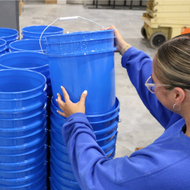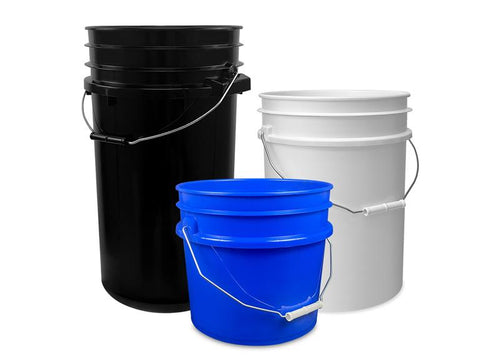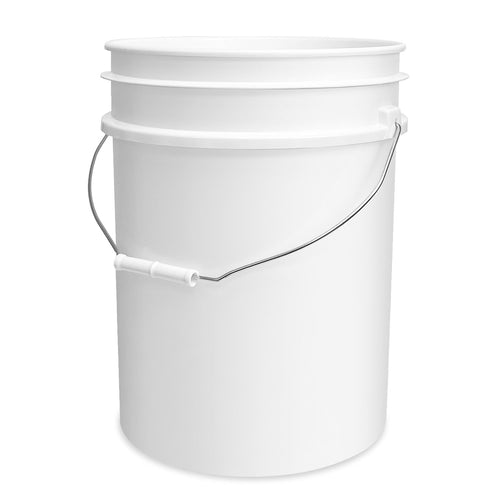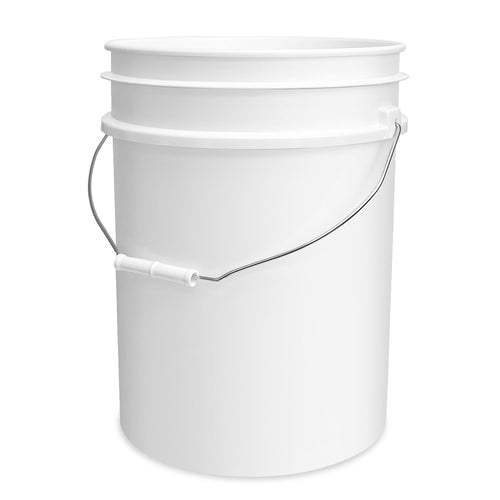Food-grade buckets are the unsung heroes of countless operations – from bustling restaurant kitchens and craft breweries to home fermenting enthusiasts and commercial food manufacturers. These versatile workhorses handle everything from ingredient storage to food processing, making them indispensable in any food-related business or hobby.
But here's the critical truth: even the highest-quality food-grade bucket is only as safe as its last cleaning. Proper sanitization isn't just about maintaining appearances – it's about protecting your products, your customers, and your reputation. A single oversight in cleaning can lead to contamination, spoilage, or worse.
At ePackageSupply, we've been supplying food-grade containers for years, and we understand that proper maintenance is just as important as the initial purchase. This comprehensive guide will walk you through professional-grade cleaning and sanitization techniques that ensure your buckets remain safe, hygienic, and ready for their next important task.

3.5, 5 and 7 gallon food-grade buckets from ePackageSupply
Why Proper Cleaning Matters (It's More Than Just Looks!)
Think about the journey your food-grade bucket takes: from storing sticky honey and fermenting sauerkraut to holding flour or liquid ingredients. Each use leaves behind residue that, if not properly removed, becomes a breeding ground for unwanted microorganisms. What might seem like a harmless film today could become tomorrow's contamination crisis.

Don't let your buckets look like this – regular cleaning prevents buildup
✅ Benefits of Proper Cleaning & Sanitization
Prevents Contamination
Eliminates harmful bacteria, viruses, and mold spores that can cause foodborne illness or product spoilage.
Maintains Food Quality
Prevents flavor transfer between batches and eliminates odors that could affect your next product.
Extends Bucket Life
Regular cleaning prevents staining, plastic degradation, and buildup that can permanently damage containers.
Ensures Compliance
Meets health department requirements and food safety standards for commercial operations.
Saves Money
Prevents product loss from contamination and reduces replacement costs by extending container lifespan.
Protects Reputation
Demonstrates professional standards and commitment to food safety, building customer trust and loyalty.
Step-by-Step Guide to Cleaning Food-Grade Buckets
Follow this proven method that food safety professionals use to ensure thorough cleaning:
Step 1: Empty and Rinse Immediately
- Empty all contents from the bucket as soon as you're done using it
- Never let food residue dry and harden – this creates a perfect environment for bacteria and makes cleaning exponentially harder
- Rinse with warm water (not hot) to remove loose debris and prevent proteins from cooking onto the surface
- Pay special attention to the bottom edges where residue tends to accumulate
Step 2: Prepare Your Cleaning Solution
- Use warm water (100-110°F) and a mild, food-safe detergent
- Recommended ratio: 1 tablespoon of dish soap per gallon of water
- Avoid harsh chemicals, bleach-based cleaners (unless properly diluted for sanitization), or abrasive cleaners that could damage the plastic
- For stubborn residue, consider using a specialized food-grade degreaser
Step 3: Scrub Thoroughly
- Use a non-abrasive sponge, soft-bristled brush, or dedicated bucket brush
- Scrub in circular motions, working from top to bottom
- Focus on: the bottom surface, side walls, rim, handles, and any grooves or textured areas
- Don't forget the outside – it harbors contaminants that can transfer to clean surfaces
- For 5-gallon buckets, consider using a long-handled brush to reach all areas comfortably
Step 4: Rinse Again (and Again!)
- This is the most critical step – residual soap can contaminate food and affect taste
- Rinse with clean, warm water at least 3 times
- Check for soap bubbles or slippery feeling – if present, keep rinsing
- Final rinse should use potable (drinking-quality) water
Step 5: Dry Completely
- Air dry by placing upside down on a clean drying rack
- Ensure good air circulation to prevent moisture pockets
- Alternative: Use clean, lint-free cloths or paper towels
- Never stack wet buckets – this traps moisture and promotes bacterial growth
- Drying time: Allow at least 2-4 hours in a well-ventilated area
Sanitization: Taking Cleanliness a Step Further
While cleaning removes visible dirt and debris, sanitization reduces microorganisms to safe levels. This extra step is crucial for food safety, especially when switching between different food types or after extended storage.
🔥 Method 1: Hot Water Sanitization (Recommended)
This is our preferred method as it's chemical-free and highly effective:
- Heat water to at least 171°F (77°C) – use a thermometer to verify (FDA Food Code requirement)
- Immerse the cleaned bucket for at least 30 seconds, or fill it with hot water
- For larger containers, fill with hot water and let stand for 2-3 minutes
- Use caution when handling hot water and containers
- Allow to air dry completely – the heat helps evaporate remaining moisture
Safety Note: Always wear heat-resistant gloves when handling hot water and heated containers.
🧪 Method 2: Chemical Sanitization (Use with Caution)
When hot water isn't available or practical:
- Chlorine bleach solution: 1 tablespoon unscented bleach per gallon of cool water (50-100 ppm)
- Contact time: Immerse or fill bucket for at least 1 minute
- Critical: Rinse thoroughly with potable water after sanitizing
- Alternative: Use commercial food-grade sanitizers following manufacturer instructions
- Never mix different sanitizers or cleaning chemicals
Important: We generally recommend hot water sanitization to avoid any risk of chemical residue affecting food products.
Tips for Maintaining Cleanliness
💡 Pro Tips from the Experts
- Clean Immediately: The golden rule – never let food residue sit. Clean within 2 hours of emptying
- Dedicate Buckets: Assign specific buckets to specific uses (e.g., one for fermenting, one for dry goods)
- Label Everything: Mark buckets with their designated use and last cleaning date
- Regular Inspections: Check for cracks, scratches, or cloudiness that could harbor bacteria
- Replace When Needed: Discard buckets with deep scratches, cracks, or permanent staining
- Create a Schedule: Establish a regular cleaning routine, even for stored buckets
- Use Liners: Consider food-grade liners for messy or staining products
Common Cleaning Mistakes to Avoid
⚠️ Avoid These Common Pitfalls
- Using the dishwasher: High heat can warp or damage food-grade plastic
- Harsh scrubbers: Steel wool or abrasive pads create micro-scratches where bacteria hide
- Mixing cleaning products: Never combine different cleaners – dangerous reactions can occur
- Inadequate rinsing: Soap residue is a common cause of off-flavors in stored food
- Stacking wet buckets: Creates a perfect environment for mold and bacterial growth
- Ignoring the lid: Lids need the same thorough cleaning as buckets
- Using non-food-safe cleaners: Household cleaners may leave toxic residues
Proper Storage After Cleaning
How you store your clean buckets is just as important as how you clean them:
- Location: Store in a clean, dry area away from chemicals and contaminants
- Position: Store upside down on clean shelving to prevent dust accumulation
- Coverage: Use clean plastic wrap or food-grade bags to cover if storing long-term
- Temperature: Avoid extreme temperatures that can degrade plastic
- Organization: Keep lids with their matching buckets to maintain seal integrity
- Documentation: Maintain a cleaning log for commercial operations
Frequently Asked Questions
Q: Can I put my food-grade buckets in the dishwasher?
A: No, it's not recommended. The high heat from dishwashers can warp or degrade food-grade plastic over time, compromising the bucket's integrity and food safety. Hand washing with warm water and mild detergent is the safest and most effective method.
Q: Do I have to sanitize my buckets every time I use them?
A: Yes, sanitization is highly recommended after each use, especially for food storage, brewing, or any application where bacteria could be a concern. Sanitizing reduces microorganisms to safe levels and prevents cross-contamination between different food products.
Q: What is the best way to remove strong odors from my bucket?
A: To neutralize strong odors, first clean thoroughly, then try soaking with a solution of baking soda (2 tablespoons per gallon of water) or diluted white vinegar (1:1 ratio with water) for 2-4 hours. Rinse thoroughly and air dry in sunlight if possible, as UV rays help eliminate odors.
Q: Why is it important to let buckets dry completely before storage?
A: Storing wet buckets creates an ideal environment for mold and bacterial growth, which can contaminate future products. Complete drying prevents moisture-related issues and ensures your buckets remain safe for food storage. Always allow at least 2-4 hours of drying time in a well-ventilated area.
Q: How often should I replace my food-grade buckets?
A: Replace buckets when you notice deep scratches, cracks, cloudiness, permanent staining, or warping. With proper care, quality food-grade buckets from ePackageSupply can last several years. Inspect regularly and replace immediately if structural integrity is compromised.
Q: What's the difference between cleaning and sanitizing?
A: Cleaning removes visible dirt, debris, and residue using soap and water. Sanitizing goes further by reducing the number of microorganisms to safe levels through heat or chemical treatment. Both steps are essential for food safety – always clean first, then sanitize.
Q: Can I use regular household bleach to sanitize food-grade buckets?
A: Yes, but only unscented household bleach at the proper dilution (1 tablespoon per gallon of water). However, thorough rinsing with potable water is critical to remove all chemical residue. We recommend hot water sanitization as a safer, chemical-free alternative.
Q: What cleaning products should I avoid?
A: Avoid harsh chemicals, scented detergents, abrasive cleaners, steel wool, and any non-food-safe products. These can damage the plastic, leave toxic residues, or create scratches where bacteria can hide. Stick to mild, food-safe detergents and soft cleaning tools.
🎯 The Bottom Line
Maintaining clean and sanitized food-grade buckets is a simple yet vital practice that protects your products, customers, and reputation. By following these professional cleaning techniques, you'll ensure your buckets remain safe, hygienic, and ready for years of reliable service. Remember: a few extra minutes spent on proper cleaning can prevent hours of problems down the road.
Ready to Upgrade Your Food Storage Solutions?
Discover our complete line of FDA-approved food-grade buckets and containers
📞 Questions about bucket selection or cleaning? Call (888) 631-0888
Our packaging experts are here to help!

 Violet Zhang
Violet Zhang
















































